
What do you want to read about?


It appears that the website Today Christian has come up with a list of questions that “Atheist Cannot Truly and Honestly REALLY ANSWER!” One reason an atheist might find it hard to answer these questions is because there is not a comment section. Beyond that, these are fairly easy to answer.
1. How Did You Become an Atheist?
This has to do with two things that happened around the same time in my life. When I was in 7th and 8th grade, I became very interested in skepticism. I started to question everything I had believed before and started realizing that there was no evidence for much of what I believed (at this time I was a believer of Bigfoot, Atlantis, Aliens, etc…). At that same time I met someone, a classmate, who identified as an atheist. Until then, I actually never knew that was an option, I thought everyone in the world believed that a god(s) existed. After that, I applied my skeptical toolkit to the idea of a god and realised that it, like much of the other things I believed in, had no evidence to support it.
2. What happens when we die?
Personally, I am donating my body to science. I want my bones to be used by future anatomists to learn the wonders of the human skeleton. However, I feel this question has more philosophical connotations about an afterlife. When I was in high school, one of my friends use to always answer this question with, “Do you remember what life was like before you were born? Why do you think it will be different after you die?” I feel that is a good enough answer until one is able to provide evidence that there is an afterlife.
3. What if you’re wrong? And there is a Heaven? And there is a HELL!
I just want to point out that by asking three questions here, our author is actually asking more than ten questions.
Well, if I go to hell, I hope I burn well.
All jokes aside, there is no reason to think that such a thing as heaven or hell exists in the first place. Beyond that, this question presupposes that the author’s version of heaven and hell are the only options to me being wrong, which is not the case. There is nothing to suggest that the Christian heaven and hell is correct. A Christian’s idea of an afterlife is just as likely to be correct as any other religion’s ideas of an afterlife. There is no reason to believe this is a dichotomy. Who knows, perhaps there is an afterlife, but it is only enjoyed by those that were truly curious enough to ask questions. The fear of hell or the reward of heaven is not a good reason to believe in something.
4. Without God, where do you get your morality from?
I get my morals from the same place the author of these questions does; Society. There is nothing to suggest that morals are anything more than our shared agreement of how we should act. The good thing about this is that our moral arc has been bending to a far more just and fair society for everyone in the past few decades. One can only hope that trend continues.
5. If there is no God, can we do what we want? Are we free to murder and rape? While good deeds are unrewarded?
This question makes no sense, seeing as how the author already believes there is a god, yet rape and murder happen all the time. The question is better turned around on the author and asked, “If there is a (loving and just) god, why is there rape and murder?”
However, to answer the question, philosophically, yes. We can do whatever we want (including rape and murder). Yet, since we live in societies, and societies shape our morals and have laws, technically, we cannot do whatever we want. There are real world consequences for our actions.
Beyond that, good deeds should be their own reward. This seems to go back to question three and the authors carrot/stick beliefs about an afterlife.
6. If there is no god, how does your life have any meaning?
I make my own meaning in life. Even if there was a god(s), this would still be true.
7. Where did the universe come from?
I honestly do not know that. From my limited understanding of cosmology; the energy that makes up our universe is eternal. However, at some point in the past that energy started the universe as we know it now. The thing is, just because I do not know the answer to this question, does not mean I will pretend to have an answer. That is what theists do when they say GodDidIt to questions like this.
8. What about miracles? What all the people who claim to have a connection with Jesus? What about those who claim to have seen saints or angels?
Again, without evidence, miracles are just claims. People today claim to have connections with aliens and see them all the time. There is just as much evidence (that is to say zero) to back their stories as there is for the people who claim to have a connection with Jesus or say they saw him or angels. Claims made without evidence can be dismissed without evidence.
9. What’s your view of Dawkins, Hitchens and Harris?
I actually know very little about Harris. He seems to have a weird “No True Muslim” argument. Beyond that, I am actually not familiar with his work at all.
Dawkins is a wonderful biologist and communicator of evolutionary theory. If someone asked me for one book about evolution, I would say The Blind Watchmaker. However, I have read The God Delusion and have to say I was unimpressed. I read both of those books well after I had a great understanding of evolution and was an atheist, thus he did not influence me much in either of those aspects.
Hitchens is in my top ten favorite persons list. Out of the Four Horsemen, I found him the most entertaining and he was probably the only one that influenced me as a young atheist, since I would watch clips of him after I became an atheist in 8th grade. I still often go back and watch clips or whole debates of Hitchens. I read God is not Great well after I was an atheist, but I think it is good and does a much better job than The God Delusion at making a case for atheism.
However, I just want to point out that I was far more influenced by skeptics and scientists on this issue, than any atheistic writers. My influences trace back far more to Randi, Shermer, Bakker, Tyson, and the Leaky clan.
10. If there is no God, then why does every society have a religion?
Religion is not synonymous with belief in a god(s). Gods (and other supernatural entities) were created to answer questions to things that people did not know. Religions were a way to worship those things and try to gain their favor by doing rituals in the hopes it would please them. Religions were also part of the government and culture of most societies. That means in many cases, if you were not apart of that religion, you were kicked out of that society or killed. It is actually a fairly recent thing to separate religion from government. One can be religious and not believe in deities. One can also believe in deities and not have a religion. That is why people can say things like, “I am spiritual, but not religious” or “I am culturally Catholic/Jewish.” Beyond that, not all religions are the same, nor are the gods they worship. Thus, what was the point of this question?
Hat tip to Heina Dadabhoy for showing me these questions first.
Last year, I was listening to a YouTube Hangout wherein one of the participants was lamenting the fact that science has taken away many of the mysteries in the universe. I could not disagree with that person more. We are lucky enough to be living in the Age of Mystery, from a scientific perspective.
The scientific method has given us answers to several questions that our ancestors pondered, however, it has also opened up whole new worlds to discover. For one example of what I am talking about, we once wondered what caused sickness. Our ancestors came up with several guesses that, for the most part, turned out to be wrong. However, the discovery of microorganisms not only led us to the correct answer about where sickness comes from, but also a whole new world of microorganisms that our ancestors could not dream existed. Since that discovery, we have never stopped exploring it and make new discoveries in that field almost daily.
Our knowledge gained through scientific investigation, has led to more and better questions about the universe than anything before. Our knowledge has exposed us to our vast ignorance of the universe. We now know the earth is 4.5 billion years old and the universe is ~14 billion years old. The numbers alone are almost inconceivable to our minds. Can you imagine all the mysteries things that we may never know about that happened in those lengths of time? The fossil record only gives us a fraction of what lived on earth, plus it becomes less and less reliable the farther back one goes. We may never have a complete picture of the life history of our own planet.
The matter that we see and interact with on a daily bases makes up ~5% of the stuff in our universe. ~95% of our universe is made out of two things (dark matter and dark energy) that we can detect, but cannot see. This amazing aspect of our universe is something that our ancestors could not have imagined to be real, and we were not aware of it until the middle and latter half of the 20th century.
14 billion years of history and 95% of the universe being barely detectable. If anything, that means science has led us to the real age of mystery. We have mapped out most of our world, we have seen many of the celestial bodies in our solar system. However, to think that because of science, there is less mystery in the world is daft. If anything, we are at the most mysterious time in our history. We are able to know just how ignorant we are of the universe, and that is an amazing thing. For every mystery science solves, it appears to open up two new ones, and I would not want it any other way.
Last month’s challenge went unguessed, meaning the final bragging rights for Know Your Bones belongs to me.
So, what is the name of the critter in last month’s challenge? It is Coelophysis bauri.
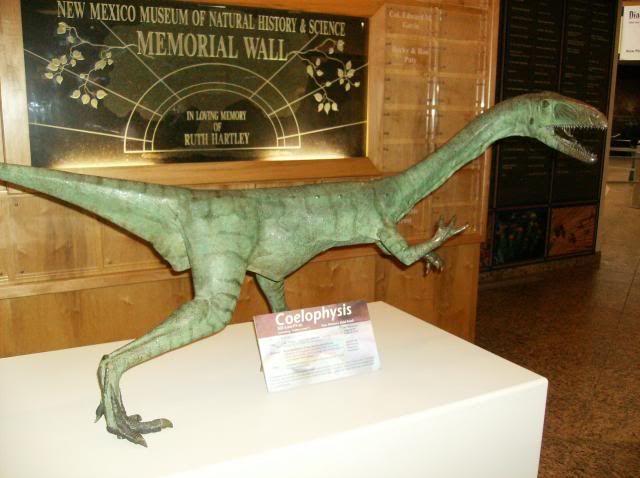
(Taken at the New Mexico Museum of Natural History and Science)
Coelophysis bauri lived during the late Triassic 208 to 228 million years ago. Most specimens are found in New Mexico, however, several specimens of related species (specimens that would be classified as Coelophysis) have been found worldwide, dating to as late as the early Jurassic. Coelophysis is one of the earliest dinosaurs known to science and the earliest known from complete specimens. Coelophysis was ~3 meters in length and would have stood ~1 meter at the hip. Coelophysis is a theropod with sharp curved teeth. It possessed four fingers on its forelimbs, which is the basal trait for theropods. It is believed that Coelophysis was a fast and agile predator.

(Taken at the New Mexico Museum of Natural History and Science)
Coelophysis is one of the earliest dinosaurs discovered, being named by Edward Drinker Cope in 1889. Coelophysis means “hollow form,” because Cope noticed that it possessed hollow bones, something shared with all later theropods. Coelophysis also possessed a furcula (i.e. a wishbone) and a sclerodic ring seen in the orbit of the skull. The sclerodic ring allowed for muscle attachments which would have given Coelophysis amazing vision, much like modern birds of prey. As pointed out above, Coelophysis is one of the earliest dinosaurs and it already had all these traits that are found in modern birds. It would not be surprising to find out that Coelophysis also possessed feathers.
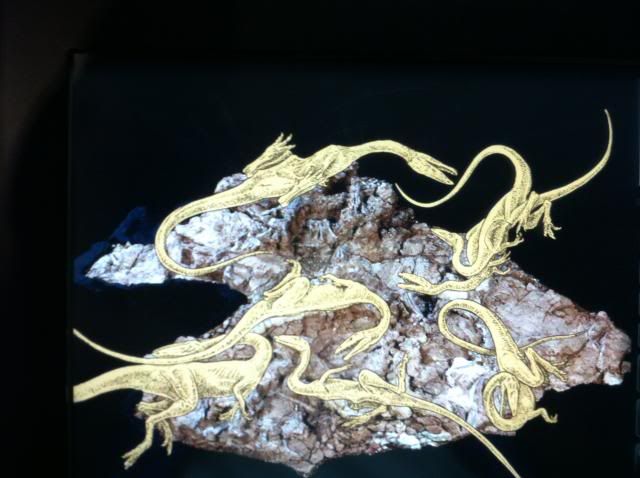
(Taken at the New Mexico Museum of Natural History and Science)
Thank you for everyone that ever participated in this. I did enjoy it, but I feel my time is better spent blogging about a different subject.
Theistic Apologists deploy several arguments to try to establish that a god(s) is necessary. In my humble opinion, the worst of all these arguments is the Fine-Tuning Argument. The Fine-Tuning Argument is essentially saying that the parameters of the universe as we know it are placed in such a way to allow life as we know it to exist. However, there are three fundamental flaws that make this easily the worst argument a theist could use to justify their deity(s).
First, when employing this argument, the theist is making the underlying assumption that the fine-tuning we see in the universe is the only possible way the universe could exist that would permit life. No justification for this is ever given, beyond the fact that if the fine-tuning were different, then things would be different; an example of a counterfactual conditional. Simply because things would be different does not mean that life or a universe could not exist. They may not be as we see them today, but that alone does not mean that the possibility for life and a universe are dependent on the fine-tuning of the universe as we know it. This is an unjustified claim built into the argument that should be challenged. Beyond that, the theist also has not shown that the fine-tuning of our universe could be anything different. It could just as easily be that all possible universes have the same fine-tuning.
Second, this argument does not take into account evolution. Built into this argument is the assumption that we (either humans or all life on this planet) perfectly fit. The Earth is just the right distance from the Sun, the Moon is just large enough to keep our axis stable, Jupiter is just large enough and far enough away to keep us safe from space junk, etc… However, what the theist usually fails to account for in this picture is the 14 billion years of history the universe has gone through, 4.543 billion years of our planet’s own history, and ~4 billion years of life history on this planet. Most of the life history we see is shaped by selection and a lot of dumb luck thrown in for good measure. Essentially, it is asinine to say this planet/universe is fine-tuned for us. If anything, we are finely-tuned by the environment.
Third and by far the largest problem for this argument. As of the writing of this post, we currently know of one planet in our solar system that supports life. That life is supported mainly on its surface, and (except for Tardigrades), species can only survive in certain environments. There are seven other planets in our solar system (plus a few hundred moons) that do not support life (as far as we know now). There are a few possible other places in our solar system that might have life (i.e. Mars and a few moons around Jupiter or Saturn). Thus, out of several celestial bodies in our solar system, there are less than ten of them that could support life. Besides this, there is empty space between those celestial bodies wherein life cannot exist. Basically, whenever a theist tries to use the Fine-Tuning Argument, they are essentially saying; “Look at this earth size planet. It has one microorganism on it. Thus, the planet must be finely-tuned for the microorganism.” Any engineer would look at that system and conclude that it was poorly tuned if its purpose was for sustaining that microorganism. If this universe was fine-tuned for anything, it was fine-tuned for creating black holes and not life.
One objection to these objections could be if the theist is willing to admit their deity(s) is not omnipotent. Most apologists in the West would not dream of giving up that aspect of their deity. However, why would an omnipotent being need to fine-tune a system in the first place? Would it not be powerful enough to create a flawless system? In addition, if it were not powerful enough to create a flawless system, how could we say it is a god?
Another objection that Abrahamic Apologists could try is “The Fall” caused this. One problem I would have with this objection is that it could account for the planet earth, but why all the other celestial bodies and the rest of the universe? Why create such a universe that would be affected by two hairless apes on a rock orbiting a nondescript star?
There appears to be nothing redeemable about this argument. In fact, this argument could be far better used to show that there is not a single omniscient and omnipotent deity that cares about life (let alone humans) for the simple fact that this universe is not finely-tuned for us. Given just one of those two attributes (omniscient or omnipotent), a human fine-tuner could produce a universe far more hospitable for life.
Last month’s challenge must not have been as challenging as I thought. The correct answer was given by WarK within an hour of the blog going up.
Deinonychus antirrhopus
This critter is indeed Deinonychus antirrhopus.
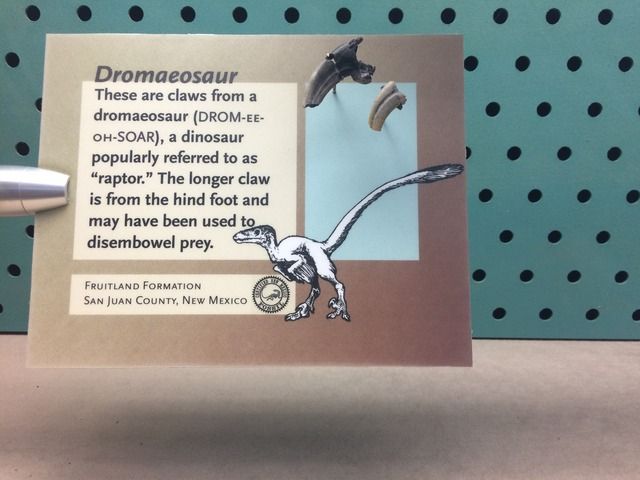
(Taken at the New Mexico Museum of Natural History and Science)
Deinonychus lived during the early Cretaceous 115 to 108 million years ago. Deinonychus stood ~87 cm at the hip, reached ~3.4 meters in length, and weight ~73 kilograms. Deinonychus lived in what is now the modern western U.S. with possible fossils of it found in eastern states. Deinonychus belongs to the dromaeosaurid clade. Deinonychus (meaning terrible claw) is named for the claw found on the second toe of each foot. This claw was retractable, meaning that it kept it off the ground so it would remain sharp for the animal’s entire life. It also had three sharp claws found on each hand.
Bite marks from Deinonychus have been found on herbivorous dinosaurs. Measuring the amount of force needed to puncture the bone reveals that Deinonychus had a bite strength roughly the same as an American alligator. It is believed that Deinonychus lived and hunted in packs. Working together, they would have been able to take down much larger animals. The first Deinonychus specimen discovered is what reignited the idea that birds were closely related to dinosaurs in the 1960s. Since than, it is now believed (based on specimens of closely related animals) that Deinonychus also possessed feathers; in fact, the whole dromaeosaurid clade could have possessed feathers.
Moving on to next month’s challenge:
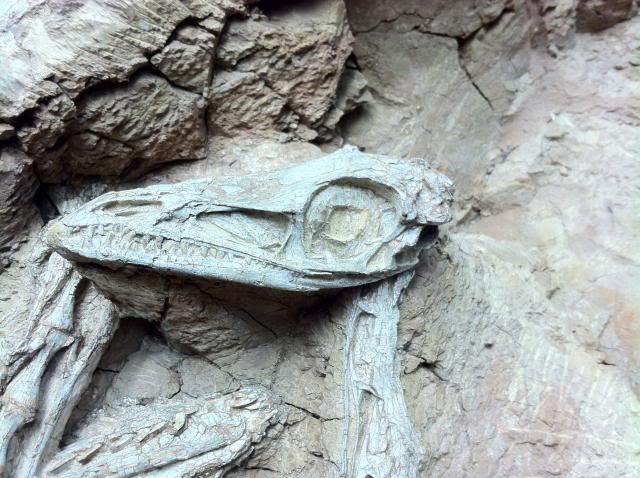
(Taken at the New Mexico Museum of Natural History and Science)
Above is the last Know Your Bones challenge I will be doing for a while. I am going to focus this blog in a different direction. I just wanted to finish off with this specimen, because it is one of my favorites.
Well, last month no one took a guess at the challenge. I am chocking that up to the up-tick in activity the blog has had recently and the holidays. Because of that and the fact that I am feeling very lazy, I am just going to repost the same challenge for this month.
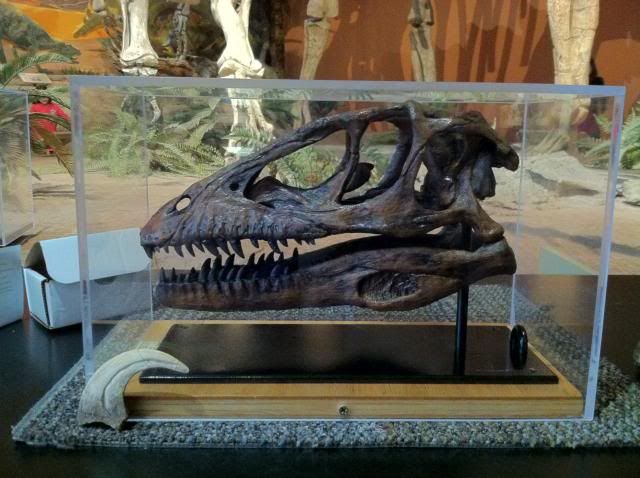
(Taken at the New Mexico Museum of Natural History and Science)
Good luck again to everyone that plays and have a happy 2016 everyone!
Last month’s challenge brought out a few good guesses and two that were correct. However, like so many other times, only one person was the most correct. Last month that happened to be our resident paleontologist Isotelus with the more correct answer.
A phytosaur; I know there’s some reassigning going on, so Pseudopalatus/Machaeroprosopus? I don’t know species names, at least not for this genus.
This critter is indeed Machaeroprosopus buceros formally known as Pseudopalatus buceros. Red identified the wrong species name and I was unaware when I picked the critter that its genus had changed. Thus, Isotelus should get extra kudos. Honestly, I picked this obscure critter mainly so WarK would not get a third victory in a row.
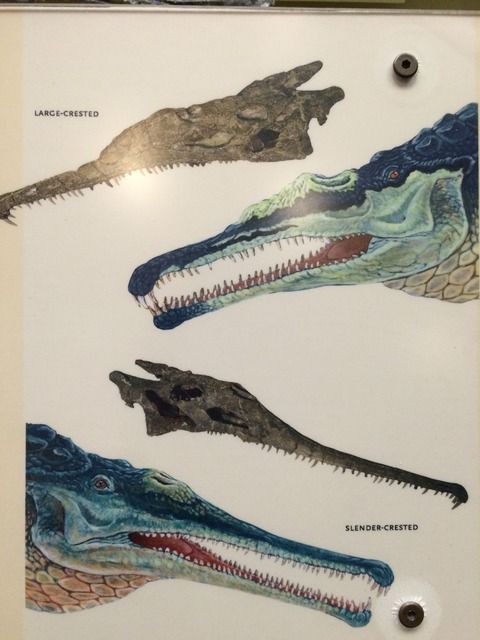
(Taken at the New Mexico Museum of Natural History and Science)
M. buceros lived during the late Triassic 205 million years ago and is found only in New Mexico. However, Machaeroprosopus species are found through out the southwest of the U.S. M. buceros grew to 3-4 meters as adults. M. buceros was an aquatic predator that would have lived its life much like a modern crocodilian, which is catching fish or ambushing prey at the shoreline. During the late Triassic, a giant swamp covered most of what is now the modern southwest of the U.S. Several different species of aquatic predator are found throughout this area and time range.
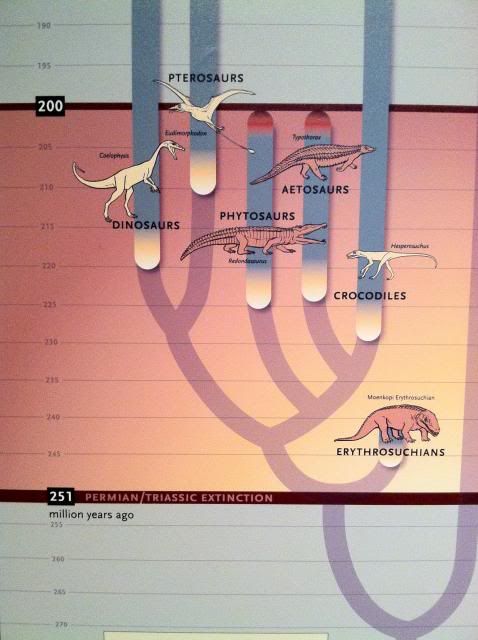
(Taken at the New Mexico Museum of Natural History and Science)
Even though it looked very similar to modern crocodilians, M. buceros was a phytosaur, which are only distantly related to crocodiles, making this a classic case of convergent evolution. One of the easiest ways to tell the difference between a crocodilian and a phytosaur is where the nasal aperture is located. On a phytosaur, the nasal aperture is located on the back of the head near the eyes, while a crocodilian’s nasal aperture is located on the tip of their snouts. The specimens of M. buceros show sexual dimorphism in the skulls. There is a robust morph believed to be male and a gracile morph believed to be female. This is mainly based on our observations of crocodilians and their sexual dimorphism in which the males are the larger of the two.
Moving on to next month’s challenge:

(Taken at the New Mexico Museum of Natural History and Science)
Good luck to everyone that plays.
I have to say, I am surprised it took so long for anyone to take a stab at guessing this iconic fossil. By the trepidation of our winner and the following guesser, perhaps the readership of this blog finds me to be a trickster. With that said what critter once owned the skull from last month’s challenge?
Something tells me this is too easy to be correct.
Tyrannosaurus rex
Nope WarK, I was not trying to trick anyone. This critter is indeed the tyrant king of the dinosaurs, Tyrannosaurus rex.
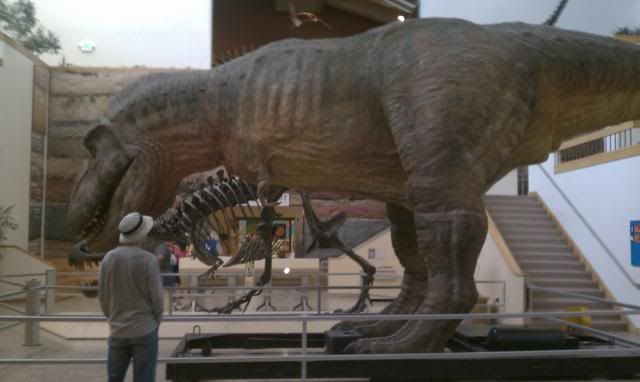
(Taken at the New Mexico Museum of Natural History and Science)
T. rex lived during the late Cretaceous 68 to 65 million years ago; it also happened to be one of the last non-avian dinosaurs that we know about. It ranged across western North America, with its fossils (mostly teeth) found from Alaska down to Mexico. T. rex could grow as large as ~4 meters at the hip, 43 meters long and weigh between 5.5 to 6.8 tons. This makes T. rex one of the largest predatory dinosaurs and one of the largest predators to ever walk the earth. Full-grown animals had a skull ~1.5 meters in length. The teeth of T. rex ranged from 30 cm long (including the root) to 13 cm long (including the root) in adults. The teeth would have been continuously replaced during life and were re-curved with ridges on the surface. T. rex famously has small arms (about the length of an adult human’s arm) with only two fingers. However, the arms appear very muscular, leading paleontologists to speculate that the arm could have been used for something (e.g. assisting in lifting the animal up when it sat down) instead of just a vestigial structure.
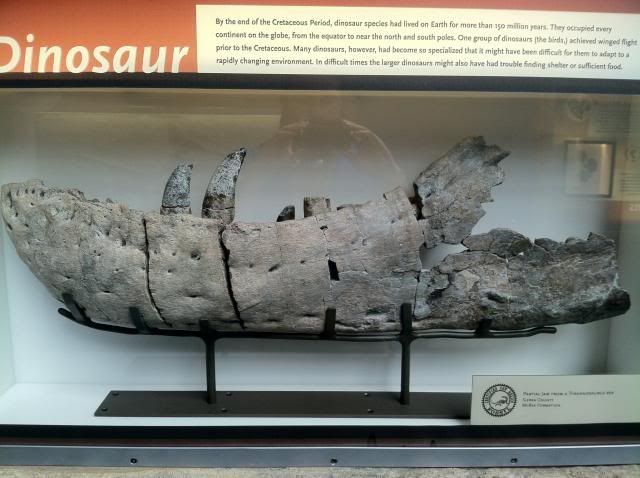
(Taken at the New Mexico Museum of Natural History and Science)
Over 30 specimens of T. rex have been discovered to date, making T. rex a very well studied dinosaur. T. rex is a theropod, but within that clade, it is closer in relation to dromaeosaurs than it is to other giant carnivores, such as Allosaurus. Because of this, and fossil finds of earlier relatives, it is possible that T. rex could have had feathers. However, a few skin impressions has only shown scales, which leads some to speculate that T. rex could have had full body feathering as a hatchling, but later sparse to no feathering as an adult due to its large size.

(Taken at the New Mexico Museum of Natural History and Science)
Two possible footprints have been found of T. rex, one of which was found in New Mexico. It measures 83 cm by 71 cm and possesses a “heel” print plus the print of the dewclaw-like forth digit found on the feet of T. rex. T. rex is also famous for being the first dinosaur found with soft tissue associated with it. In 2005, Dr. Mary Schweitzer published her discovery of it, since than several more finds have been made of soft tissue. Dr. Schweitzer and others have found trace soft tissues, and when they are analyzed and compared to living organisms, it shows that T. rex’s closest living relatives are birds. These findings align with the conclusions paleontologists were making for decades based on morphology.
Moving on to next month’s challenge:
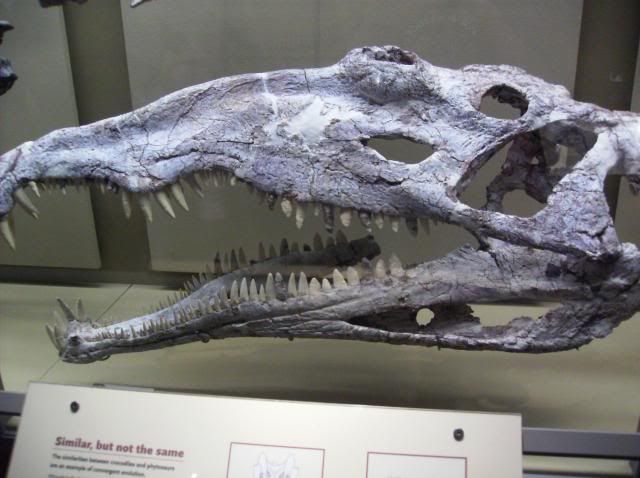
(Taken at the New Mexico Museum of Natural History and Science)
Good luck to all that play.
There were only two guesses for last month’s challenge, both correct, but one being more correct. I have a feeling that the reason only two people guessed is because this one was such an easy specimen. So, who won, who was the more correct of the two?
Camarasaurus
It turned out to be WarK, because the other guesser gave the wrong species name. The critter from last month is Camarasaurus supremus.
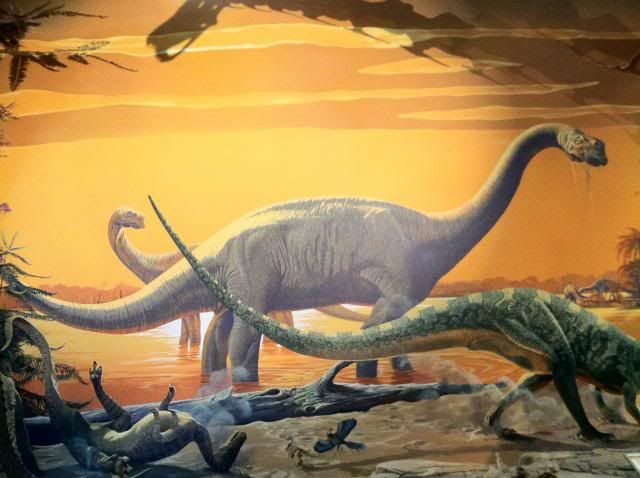
(Taken at the New Mexico Museum of Natural History and Science)
Camarasaurus lived during the late Jurassic 155 to 145 million years ago. It ranged across most of North America and is an extremely common dinosaur in the Morrison Formation. Camarasaurus had an average length of 18 meters and weighed up to 18 tons. Remarkably, several complete skeletons of Camarasaurus have been discovered in Wyoming, Colorado, Utah, and New Mexico. Based on their fossil abundance it is assumed that they roamed around North America in large numbers during the late Jurassic and may have had one of the largest populations of sauropods, if not dinosaurs, known thus far.
Camarasaurus means “chambered lizard;” it most likely got this name from the hollow bones that make up much of the vertebra or the many fenestrae found on the skull. Camarasaurus had chisels shaped teeth that were 19 cm long. The shape of the teeth and strength of the skull suggest that Camarasaurus specialized in eating coarser plant matter. This is different from other sauropods, thus Camarasaurus most likely inhabited a different environment then its cousins that also lived during this time. Camarasaurus remains are found together in a lot of sites, suggesting that they lived and died in herds.
Moving on to this month’s challenge:

(Taken at the New Mexico Museum of Natural History and Science)
Here we have a terrifying critter, which is appropriate for this month. Thanks for playing and good luck.